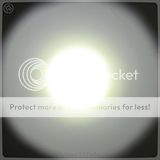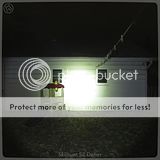Like :thumbsup: my reviews on facebook!
Don't forget to click "Like" after the page loads!
Skilhunt has long been a maker of high quality professional flashlights. The S2 is the most recent update to their Defier series, which they classify as "Hunting and Tactical". The S2 claims a max output of 950 lumens, and is controlled by both a mechanical rear switch and an electronic side switch.

Thanks to Skilhunt for providing the S2 for review.
I'll be reviewing the S2 in two sections: first, I'll discuss the light objectively (the facts about the light itself), then I'll discuss the light subjectively (my impressions about the light's performance when used for specific applications). If you have any other specific applications you'd like the light tested for, let me know and I'll see what I can do.
Video Review
Below is a video review of the S2. Due to my old image hosting site closing down, I've got new restrictions on image uploads and have replaced the "Construction" section of my reviews with a more detailed video review.
This video is available in 1080p HD, but defaults to a lower quality. To select the playback quality click the settings button (looks like a gear) after you've started the video.
Objective
Manufacturer's Specifications
Price: 90 USD

Dimensions

Plus, here's a few shots with some good detail.




User Interface
Coming soon...
Action Shots
You can click on any of these shots to see them full size.
Light in Hand




White Wall (Low, Medium, High)
ISO 100, f/3.3, 1/20"




BeamSlice

MugShot

Indoor Shots (Low, Medium, High)
ISO 100, f/3.3, 1"




Outdoor Shots (Low, Medium, High)
ISO 100, f/3.3, 2.5"




Long-Range Shots (High)
ISO 100, f/3.3, 5"
Performance
Submersion: I submersed the S2 under a foot of water for about an hour, clicking the switch several times. I found no evidence of water entering or damaging the light.
Heat:
Drop: I dropped the S2 from about a meter onto various surfaces (including grass, carpet, dirt, and hard wood), and found no cosmetic or functional damage.
Reverse Polarity Protection:
Over-Discharge Protection:
Spectral Analysis

All light that we see as white is actually made up of several different colors put together. The relative intensities of the different colors in the mix are what determine the tint of the white we see. For example, cool white LED's have a lot of blue, and warm white LED's have more red or yellow. This measurement was done on a home made spectrometer. The plot below the picture is corrected for the spectral sensitivity of the human eye. Note: the peak in the 900nm region doesn't really exist, it's a piece of the second-order spectrum that's showing up here because of the high intensity of the light source.
Output and Runtime

ANSI FL-1 runtime ratings are the time it takes for a light to fall to 10% of it's original output (counting from 30 seconds after turning the light on).
The vertical axis of the graphs below represents a relative brightness measurement using a home made light box. The horizontal axis is time in hours:minutes:seconds. Runtimes are stated in hours:minutes:seconds. These graphs may be truncated to show detail.
Mode Comparison
Turbo

High

Medium

Throwing Distance
ANSI FL-1 standard for stating a light's throwing distance is the distance at which the peak beam intensity (usually at the center of the beam) is 0.25 lux. I calculate throwing distance and candela (lux at 1 meter) by measuring peak beam intensity at five different distances and using the formula lux*distance^2=constant.
Peak Beam Intensity:
Throw Distance:
Subjective Review
Quick break down:
+
-
Long Term Impressions
I'll fill this part in after carrying the light for a while. If nothing get's added here, either I find nothing else worth noting about the light, or I end up not using it often.
Don't forget to click "Like" after the page loads!
Skilhunt has long been a maker of high quality professional flashlights. The S2 is the most recent update to their Defier series, which they classify as "Hunting and Tactical". The S2 claims a max output of 950 lumens, and is controlled by both a mechanical rear switch and an electronic side switch.

Thanks to Skilhunt for providing the S2 for review.
I'll be reviewing the S2 in two sections: first, I'll discuss the light objectively (the facts about the light itself), then I'll discuss the light subjectively (my impressions about the light's performance when used for specific applications). If you have any other specific applications you'd like the light tested for, let me know and I'll see what I can do.
Video Review
Below is a video review of the S2. Due to my old image hosting site closing down, I've got new restrictions on image uploads and have replaced the "Construction" section of my reviews with a more detailed video review.
This video is available in 1080p HD, but defaults to a lower quality. To select the playback quality click the settings button (looks like a gear) after you've started the video.
Objective
Manufacturer's Specifications
Price: 90 USD

Dimensions

Plus, here's a few shots with some good detail.




User Interface
Coming soon...
Action Shots
You can click on any of these shots to see them full size.
Light in Hand




White Wall (Low, Medium, High)
ISO 100, f/3.3, 1/20"




BeamSlice

MugShot

Indoor Shots (Low, Medium, High)
ISO 100, f/3.3, 1"




Outdoor Shots (Low, Medium, High)
ISO 100, f/3.3, 2.5"




Long-Range Shots (High)
ISO 100, f/3.3, 5"
Performance
Submersion: I submersed the S2 under a foot of water for about an hour, clicking the switch several times. I found no evidence of water entering or damaging the light.
Heat:
Drop: I dropped the S2 from about a meter onto various surfaces (including grass, carpet, dirt, and hard wood), and found no cosmetic or functional damage.
Reverse Polarity Protection:
Over-Discharge Protection:
Spectral Analysis

All light that we see as white is actually made up of several different colors put together. The relative intensities of the different colors in the mix are what determine the tint of the white we see. For example, cool white LED's have a lot of blue, and warm white LED's have more red or yellow. This measurement was done on a home made spectrometer. The plot below the picture is corrected for the spectral sensitivity of the human eye. Note: the peak in the 900nm region doesn't really exist, it's a piece of the second-order spectrum that's showing up here because of the high intensity of the light source.
Output and Runtime

ANSI FL-1 runtime ratings are the time it takes for a light to fall to 10% of it's original output (counting from 30 seconds after turning the light on).
The vertical axis of the graphs below represents a relative brightness measurement using a home made light box. The horizontal axis is time in hours:minutes:seconds. Runtimes are stated in hours:minutes:seconds. These graphs may be truncated to show detail.
Mode Comparison
Turbo

High

Medium

Throwing Distance
ANSI FL-1 standard for stating a light's throwing distance is the distance at which the peak beam intensity (usually at the center of the beam) is 0.25 lux. I calculate throwing distance and candela (lux at 1 meter) by measuring peak beam intensity at five different distances and using the formula lux*distance^2=constant.
Peak Beam Intensity:
Throw Distance:
Subjective Review
Quick break down:
+
-
Long Term Impressions
I'll fill this part in after carrying the light for a while. If nothing get's added here, either I find nothing else worth noting about the light, or I end up not using it often.
Last edited:

